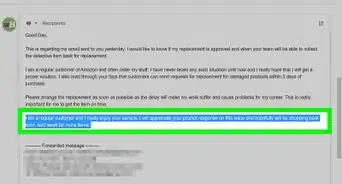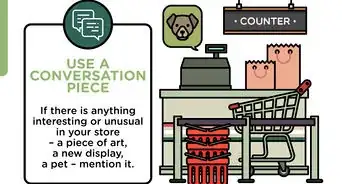wikiHow is a “wiki,” similar to Wikipedia, which means that many of our articles are co-written by multiple authors. To create this article, 10 people, some anonymous, worked to edit and improve it over time.
This article has been viewed 142,520 times.
Learn more...
One of the most common reasons for the failure of a business venture, large or small, is its inability to deliver value to customers. The concept of value is one of those things that is both simple and complex. Simple because it only has three components; complex because it can only be defined by the customer, and can include tangible and intangible concepts such as perceptions and opinions. This article is intentionally simplistic, so as to introduce the concepts in their most basic form.
Steps
-
1Understand that the first component of value is "utility." It means that whatever you are delivering to your customer has to be fit for the purpose the customer will give to it. In essence, for any goods or service you deliver to a customer, having utility means that the customer can enhance the performance of their own assets, or remove some sort of constraint that prevents them from receiving more value from their assets.
- If it is a car wash, the car has to end up clean.
- If it is a snow plowing service, the customer has to be able to traverse the path you plowed as the customer defined.
- If it is a cellphone, the phone must be able to receive a signal, the customer must be able to dial a number and connect to someone on the other end of the call.
- If a computer report, the customer will have to be able to click on a button on the screen, the report must come out of the printer and it must be complete and correct.
-
2Know that the next component is "warranty." It means that the goods or services that you deliver to your customer must be fit for use.
- The car wash, for example, has to be open at the time the sign says the business will be open, and it must be able to handle the demand for its use, otherwise the line will grow long, customers will tire of waiting and will leave.
- The service must be as secure as the customer expects; no undue risks for the driver or passengers, for example.
- If the service fails, it should be restored within the period of time the customer considers reasonable, otherwise the customer will go find another car wash.
- The same concepts apply to all other goods and services. They have to be as available as the customer considers appropriate, provide the right capacity to meet the customer's demand, be as secure as the customer expects them to be and as continuous as is considered reasonable by the customer.
Advertisement -
3Strive to identify and overcome the barriers of the customer's perceptions. The easiest way to explain this is to think back to the day you bought your last automobile. Why did you pick that one? After all, all cars are the same –– four wheels, chassis, engine, transmission, differential, body, seats, steering wheel, glass, seat belts, etc... Or are they? The job of the salesperson who wants to make the sale is to identify these perceptions and determine the best way to present the service –– a car –– in a way that will convince the customer that this is the vehicle that meets all of the requirements, real and perceived.
- Some customers will buy on the basis of the perception of reliability, created through personal experiences and/or word of mouth.
- Some will focus on price.
- Some will focus on the capacity, or the comfort of the interior.
- Some will want speed, others think there can never be enough airbags on a moving vehicle.
-
4The perceptions of the customer are what makes or breaks the transaction that exchanges value for money. For example, most people would not pay $100 for a can of corned beef, right? However, put a person in a situation where that person has not eaten for days and that's all to be found, and that person will exchange anything of value for that food. The art of selling boils down to finding what the customer wants that they consider to be of value, and convincing them that what you have for sale will deliver that value.
-
5Remember that strategy and marketing are two different concepts.
- Strategy is about deciding what you will offer that is of value to potential customers, how that value will be delivered, and how you will convince the customer that the value the customer wants should be obtained from you. In short, it's about defining the value proposition.
- Marketing is about communicating the strategy and value proposition to a customer in a way that will make them want to buy the service or goods from you.
-
6Pursue positive returns. Where does money come into play in all of this? The customer must perceive that the total value of the service is higher than its cost, and produces a positive return. The return can be tangible (as in a positive Return on Investment) or intangible (as in an increase in the reputation of the customer's brand, or the goodwill of the customer's customers). Keep in mind that sometimes intangible returns can be much more valuable than tangible ones!
Community Q&A
-
QuestionWhat customer problems am I solving in a catering business?
 Community AnswerThe value of a catering business is providing a meal in a situation where the person purchasing the service does not have the time or skills to prepare and deliver such a meal, including all the things that happen before and after the service is delivered. The meal must meet the menu requirements, but must also be delivered at the agreed time, have enough food to feed the number of guests, must not make people sick and if something goes wrong, there is a contingency plan.
Community AnswerThe value of a catering business is providing a meal in a situation where the person purchasing the service does not have the time or skills to prepare and deliver such a meal, including all the things that happen before and after the service is delivered. The meal must meet the menu requirements, but must also be delivered at the agreed time, have enough food to feed the number of guests, must not make people sick and if something goes wrong, there is a contingency plan. -
QuestionHow can a business change a customer's perspectives of security, customer service, and added value?
 Community AnswerCommunicating to your customer the measures you take to protect their personal data can change their perspective of security. Polling customers on the quality of customer service, advertising the positives, and showing that you have taken measures to address the negatives can all change perspectives on customer service, and customer testimonials about how your products have added value to your customers' lives can help with changing perspectives on added value.
Community AnswerCommunicating to your customer the measures you take to protect their personal data can change their perspective of security. Polling customers on the quality of customer service, advertising the positives, and showing that you have taken measures to address the negatives can all change perspectives on customer service, and customer testimonials about how your products have added value to your customers' lives can help with changing perspectives on added value. -
QuestionHow could a restaurant business explore, create and deliver value?
 JuanCommunity AnswerExplore value: Ask your customers. Sit down at the table and talk to them about their perception of your restaurant, your food, the ambiance, the service, etc. Or ask them to fill out surveys in return for a discount coupon, for example. Create and deliver: Read the article again. Creating value is about delivering something that the customer wants, in the way the customer wants it. Take the feedback you've gotten from your interviews or surveys and make it happen.
JuanCommunity AnswerExplore value: Ask your customers. Sit down at the table and talk to them about their perception of your restaurant, your food, the ambiance, the service, etc. Or ask them to fill out surveys in return for a discount coupon, for example. Create and deliver: Read the article again. Creating value is about delivering something that the customer wants, in the way the customer wants it. Take the feedback you've gotten from your interviews or surveys and make it happen.
Warnings
- Remember that the perceptions of customers can change from one day to the next. If you're delivering services on a regular basis, it is important to ask the right questions, and develop trust and credibility with the customer, to be able to detect when those perceptions change, and be able to adjust and realign to the customer's new definition of value.⧼thumbs_response⧽
- The worst mistake you can make is to try to define value for a customer without consulting the customer. In any business relationship, only one party ever defines the value of goods or services -- the customer.⧼thumbs_response⧽
































































